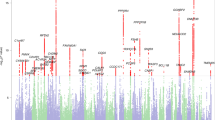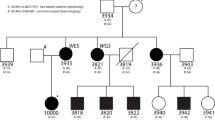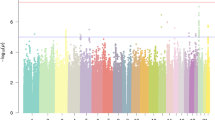Abstract
There is a compelling body of evidence that developmental dyslexia runs in families and seems to be highly inheritable. Several investigations during the last two decades have shown possible locations of genes that might be involved in dyslexia, including regions of chromosomes 1, 2, 3, 6, 11, 13, 15 and 18. In addition, six candidate genes (KIAA0319, DYX1C1, DCDC2, ROBO1, MRPL19 and C2ORF3) seem to be related to dyslexia. The present study carried out a whole genome scan in a six-generation pedigree. In addition to literacy skills the assessment included cognitive skills and records concerning the history of reading and writing ability. Thirty-five percent were regarded as dyslexic in the family. A linkage analysis using both a quantitative and a qualitative approach has been performed. No evidence was obtained to support the hypothesis that the transmission of dyslexia in this pedigree is due to a highly penetrant major gene, and previous linkage findings were not replicated; however, power in this small study was not adequate to confirm linkage of genes with small to moderate effects. The results were discussed in relation to diagnostic procedures and sample characteristics.


Similar content being viewed by others
References
Almasy L, Blangero J (1998) Multipoint quantitative trait linkage analysis in general pedigrees. Am J Hum Genet 62:1198–1211
Anthoni H, Zucchelli M, Matsson H et al (2007) A locus on 2p12 containing the co-regulated MRPL19 and C2ORF3 genes is associated to dyslexia. Hum Mol Genet 16:667–677
Barr L, Couto M (2007) Molecular genetics of reading. In Grigorenko E, Naples AJ (eds) Single word reading: behavioural and biological perspectives. Psychology Press, pp 255–281
Bates TC, Luciano M, Castles A, Coltheart M, Wright MJ, Martin NG (2007) Replication of reported linkage for dyslexia and spelling and suggestive evidence for novel regions on chromosomes 4 and 17. Eur J Hum Genet 15:194–203
Brkanac Z, Chapman NH, Matsushita MM, Chun L, Nielsen K, Cochrane E et al (2007) Evaluation of candidate genes for DYX1 and DYX2 in families with dyslexia. Am J Med Genet B 144b:556–560
Cardon LR, Smith SD, Fulker DW, Kimberling WJ, Pennington BF, DeFries JC (1994) Quantitative trait locus for reading disability on chromosome 6. Science 266:276–279
Cope NA, Hill G, Moskvina V, Stevensen J, Holmans P, Owen MJ et al (2005a) Strong evidence that KIAA0319 on chromosome 6p is a susceptibility gene for developmental dyslexia. Am J Hum Genet 76:581–591
Cope NA, Hill G, van den Bree M, Harold D, Moskvina V, Green EK et al (2005b) No support for association between dyslexia susceptibility 1 candidate 1 and developmental dyslexia. Mol Psychiatry 10:237–238
de Kovel CGF, Franke B, Hol FA, Lebrec JJP, Maassen B, Brunner H et al (2008) Confirmation of dyslexia susceptibility loci on chromosomes 1p and 2p, but not 6p in a Dutch sib-pair collection. Am J Med Genet B 147b:294–300
DeFries JC, Gillis JJ (1993) Genetics of reading disabilities. In: Plomin R, McClearn G (eds) Nature, nurture, and psychology. APA Press, Washington, DC, pp 121–145
Fagerheim T, Raeymaekers P, Tønnessen FE, Pedersen M, Tranebjærg L, Lubs HA (1999) A new gene (DYX3) for dyslexia is located on chromosome 2. J Med Genet 36:664–669
Field LL, Kaplan BJ (1998) Absence of linkage of phonological coding dyslexia to chromosome 6p23–p21.3 in a large data set. Am J Hum Genet 63:1448–1456
Fisher SE, DeFries JC (2002) Developmental dyslexia: genetic dissection of a complex cognitive trait. Nat Neurosci 3:767–780
Fisher SE, Smith SD (2001) Progress towards the identification of genes influencing developmental dyslexia. In: Fawcett AJ (ed) Dyslexia: theory and good practice. Whurr, London, pp 39–64
Fisher SE, Marlow AJ, Lamb J, Maestrini E, Williams DF, Richardson AJ et al (1999) A quantitative-trait locus on chromosome 6p influences different aspects of developmental dyslexia. Am J Hum Genet 64:146–156
Fisher SE, Francks C, Marlow AJ, MacPhie L, Newbury DF, Cardon LR et al (2002) Independent genome-wide scans identify a chromosome 18 quantitative-trait locus influencing dyslexia. Nat Genet 30:86–91
Frost J, Madsbjerg S, Niedersøe J, Olofsson Å, Sørensen PM (2005) Semantic and phonological skills in predicting reading development: from 3–16 years of age. Dyslexia 11:79–92
Gathercole SE (2006) Nonword repetition and word learning: the nature of the relationship. Appl Psycholinguist 27:513–543
Gayán J, Olson RK (2003) Genetic and environmental influences on individual differences in printed word recognition. J Exp Child Psychol 84:97–123
Grigorenko EL (2001) Developmental dyslexia: an update on genes, brains, and environments. J Child Psychol Psychiatry 42:91–125
Grigorenko EL (2005) A conservative meta-analysis of linkage and linkage-association studies of developmental dyslexia. Sci Stud Read 9:285–316
Grigorenko EL, Wood FB, Meyer MS, Hart LA, Speed WC, Shuster A et al (1997) Susceptibility loci for distinct components of developmental dyslexia on chromosomes 6 and 15. Am J Hum Genet 60:27–39
Grigorenko EL, Wood FB, Meyer MS, Pauls JED, Hart LA, Pauls DL (2001) Linkage studies suggest a possible locus for developmental dyslexia on chromosome 1p. Am J Med Genet 105:120–129
Grigorenko EL, Ngorosho D, Jukes M, Bundy D (2006) Reading in able and disabled readers from around the word: same or different? An illustration from a study of reading-related processes in a Swahili sample of siblings. J Res Read 29:104–123
Grigorenko E, Naples A, Chang J, Romano C, Ngorosho D, Kungulilo S, Jukes M, Bundy D (2007) Back to Africa: tracing dyslexia genes in East Africa. Read Writ Interdiscip J 20:27–49
Gudbjartsson DF, Thorvaldsson T, Kong A, Gunnarsson G, Ingolfsdottir A (2005) Allegro version 2. Nat Genet 37:1015–1016
Hallgren B (1950) Specific dyslexia (“congenital word blindness”): a clinical and genetic study. Acta Psychiatr Neurol 65:2–289
Hannula-Jouppi K, Kaminen-Ahola N, Taipale M, Eklund R, Nopola-Hemmi J, Kääriäinen H et al (2005) The axon guidance receptorgene ROBO1 is a candidate gene for developmental dyslexia. PLoS Genet 1:467–474
Høien T, Lundberg I (2001) Dyslexia: from theory to intervention. Kluwer Academic Publishers, Dordrecht, NL
Hsiung GY, Kaplan BJ, Petryshen TL, Lu S, Field LL, Stein CM et al (2004) A dyslexia susceptibility locus (DYX7) linked to dopamine D4 receptor (DRD4) region on chromosome 11p15.5. Am J Med Genet 125:112–119
Kaplan DE, Gayán J, Ahn J, Won T-W, Pauls D, Olson RK et al (2002) Evidence for linkage and association with reading disability on 6p21.3–22. Am J Hum Genet 70:1287–1298
Lubs HA, Rabin M, Feldman E, Jallad BJ, Kushch A, Gross-Glenn K (1993) Familial dyslexia: genetic and medical findings in eleven three generation families. Ann Dyslexia 43:47–60
McGrath LM, Smith SD, Pennington BF (2006) Breakthroughs in the search for dyslexia candidate genes. Trends Mol Med 12:333–342
Meng H, Smith SD, Hager K, Held M, Liu J, Olson RK et al (2005) DCDC2 is associated with reading disability and modulates neuronal development in the brain. Natl Acad Sci 102:17053–17058
Nopola-Hemmi J, Myllyluoma B, Haltia T, Taipale M, Ollikainen V, Ahonen T et al (2001) A dominant gene for developmental dyslexia on chromosome 3. J Med Genet 38:658–664
Olson RK (2007) Introduction to the special issue on genes, environment and, reading. Read Writ 20:1–11
Olson RK, Wise B, Conners F, Rack J, Fulker D (1989) Specific deficits in component reading and language skills: genetic and environmental influences. J Learn Disabil 22, 339–348. Baltimore: Brookes
Petryshen TL, Kaplan BJ, Liu MF, Field LL (2000) Absence of significant linkage between phonological coding dyslexia and chromosome 6p23–21.3, as determined by use of quantitative-trait methods: confirmation of qualitative analyses. Am J Hum Genet 66:708–714
Petryshen TL, Kaplan BJ, Liu MF, Schmill de French N, Tibias R, Hughes ML et al (2001) Evidence for a susceptibility locus on chromosome 6q influencing phonological coding dyslexia. Am J Med Genet 105:507–517
Plomin R, Kovas Y (2005) Generalist genes and learning disabilities. Psychol Bull 131:592–617
Ramus F, Szenkovits G (2008) What phonological deficit? Q J Exp Psychol 61:129–141
Raven JC (1995) Standard progressive matrices sets A–E. Oxford Psychologists Press Ltd, Oxford
Rutter M (2002) Nature, nurture, and development: from evangelism through science toward policy and practice. Child Dev 73:1–21
Scerri TS, Schulte-Körne G (2010) Genetics of developmental dyslexia. Eur Child Adolesc Psychiatry 19:179–197
Schulte-Körne G, Grimm T, Nöthen MM, Müller-Myhsok B, Cichon S, Vogt IR et al (1998) Evidence for linkage of spelling disability to chromosome 15. Am J Hum Genet 63:279–282
Schumacher J, König IR, Plume E, Propping P, Warnke A, Manthey M et al (2006) Linkage analyses of chromosomal region 18p11–q12 in dyslexia. J Neural Transm 113:417–423
Siegel LS (1999) Issues in the definition and diagnosis of learning disabilities: a perspective on Guckenberger v. Boston University. J Learn Disabil 32:304–319
Smith SD (2007) Genes, language development and language disorders. Ment Retard Dev Disabil Res Rev 13:96–105
Smith SD, Kimberling WJ, Pennington BF, Lubs HA (1983) Specific reading disability: identification of an inherited form through linkage analysis. Science 219:1345
Snowling MJ (2008) Specific disorders and broader phenotypes: the case of dyslexia. Q J Exp Psychol 61:142–156
Stanovich K, Siegel L (1994) Phenotypic performance profile of children with reading disabilities: a regression-based test of the phonological-core variable-difference model. J Educ Psychol 86:24–53
Statistics Sweden (2009). Announcement nr. 2010:102, http://www.scb.se/Pages/PressRelease_291846.aspx
Svensson I (2003) Phonological dyslexia: cognitive, behavioural and hereditary aspects. Doctoral thesis, The Department of Psychology, The University of Gothenburg
Taipale M, Kaminen N, Nopola-Hemmi J, Haltia T, Myllyluoma B, Lyytinen H, Muller K et al (2003) A candidate gene for developmental dyslexia encodes a nuclear tetratricopeptide repeat domain protein dynamically regulated in brain. Natl Acad Sci USA 100:11553–11558
Uppstad PH, Tønnessen FE (2007) The notion of phonology in dyslexia research: cognitivism—and beyond. Dyslexia 13:154–174
van der Leij A, de Jong PF, Rijswijk-Prins H (2001) Characteristics of dyslexia in a Dutch family. Dyslexia 7:105–124
Wadsworth SJ, Corley RP, Hewitt JK, Plomin R, DeFries JC (2002) Parent-offspring resemblance for reading performance at 7, 12 and 16 years of age in the Colorado adoption project. J Child Psychol Psychiatry 6:769–794
Wagner RW (2005) Understanding genetic and environmental influences on the development of reading: reaching for higher fruit. Sci Stud Read 9:317–326
Wigg KG, Couto JM, Feng Y, Anderson B, Cate-Carter TD, Macciardi F et al (2004) Support for EKNI as the susceptibility locus for dyslexia on 15q21. Mol Psychiatry 9:11–1121
Zhou K, Asherson P, Sham P, Franke B, Anney RJL, Buitelaar J et al (2008) Linkage to chromosome 1p36 for attention-deficit/hyperactivity disorder traits in school and home settings. Biol Psychiatry 64:571–576
Author information
Authors and Affiliations
Corresponding author
Additional information
Edited by Elena Grigorenko and Brett Miller.
Rights and permissions
About this article
Cite this article
Svensson, I., Nilsson, S., Wahlström, J. et al. Familial Dyslexia in a Large Swedish Family: A Whole Genome Linkage Scan. Behav Genet 41, 43–49 (2011). https://doi.org/10.1007/s10519-010-9395-4
Received:
Accepted:
Published:
Issue Date:
DOI: https://doi.org/10.1007/s10519-010-9395-4




